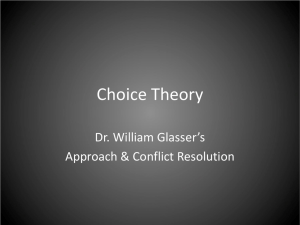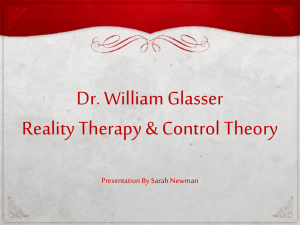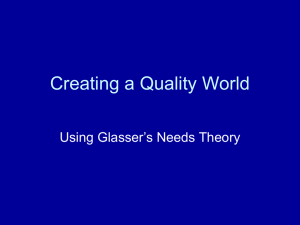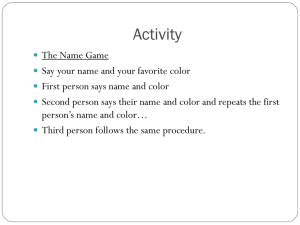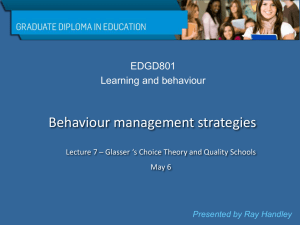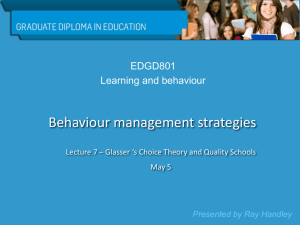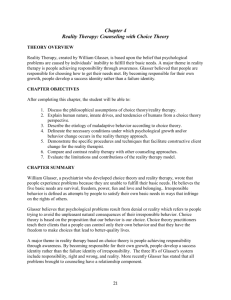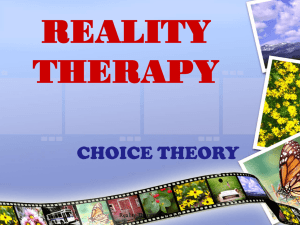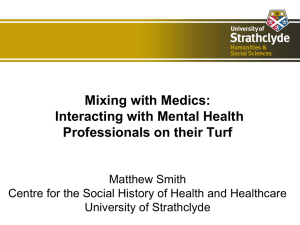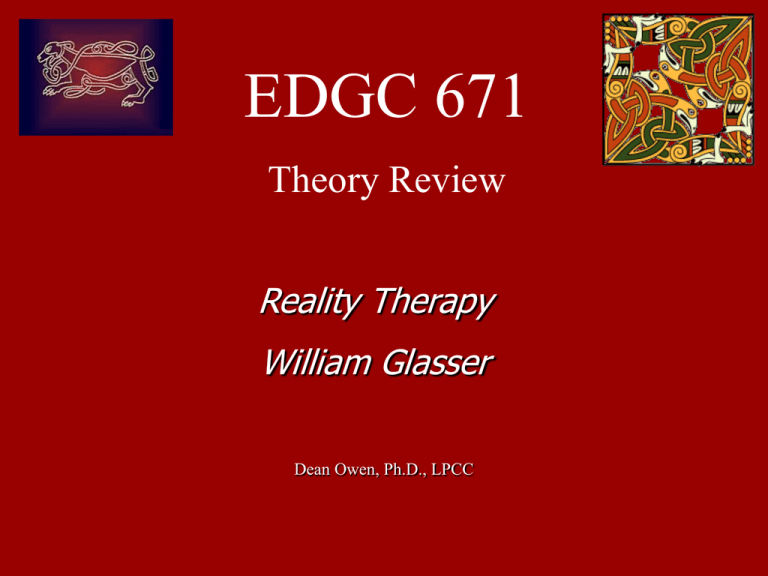
EDGC 671
Theory Review
Reality Therapy
William Glasser
Dean Owen, Ph.D., LPCC
Usual Disclaimer
Avoid prolonged contact with skin
Not to be taken internally
No animals were harmed during the
production of this presentation
After viewing this presentation avoid
operating mobile or dangerous equipment
This presentation contains graphic images
which some viewers may find disturbing.
Reality Therapy
Ultimately I must deal
with the world as it is…not
as I wish it to be.
Reality Therapy
William Glasser
1925-
Reality Therapy
William Glasser, M.D. is a Jewish American psychiatrists bone in Cleveland,
Ohio, in 1925.
Developer of Reality Therapy and Choice Theory.
His ideas, which focus on personal choice, personal responsibility and
personal transformation, are considered controversial by mainstream
psychiatrists, who focus instead on classifying psychiatric syndromes, and
who often prescribe psychotropic medications to treat mental disorders.
Glasser is also notable for applying his theories to broader social issues, such
as education, management, and marriage, to name a few.
Glasser notably deviates from conventional psychiatrists by warning the
general public about the potential detriments caused by the profession of
psychiatry in its traditional form because of the common goal to diagnose a
patient with a mental illness and prescribe medications to treat the particular
illness when, in fact, the patient may simply be acting out of unhappiness, not
a brain disorder. Glasser advocated the consideration of mental health as a
public health issue.
Reality Therapy
William Glasser, M.D. is a Jewish American psychiatrists bone in Cleveland,
Ohio, in 1925.
Developer of Reality Therapy and Choice Theory.
His ideas, which focus on personal choice, personal responsibility and
personal transformation, are considered controversial by mainstream
psychiatrists, who focus instead on classifying psychiatric syndromes, and
who often prescribe psychotropic medications to treat mental disorders.
Glasser is also notable for applying his theories to broader social issues, such
as education, management, and marriage, to name a few.
Glasser notably deviates from conventional psychiatrists by warning the
general public about the potential detriments caused by the profession of
psychiatry in its traditional form because of the common goal to diagnose a
patient with a mental illness and prescribe medications to treat the particular
illness when, in fact, the patient may simply be acting out of unhappiness, not
a brain disorder. Glasser advocated the consideration of mental health as a
public health issue.
Reality Therapy
Principle Emphasis
To help clients make more
responsible choices in their
lives and to become more
responsible in their own
behavior.
Reality Therapy
Its success caused it to be widely adopted
in schools, agencies, parenting,
management and virtually every form of
human interaction.
Reality Therapy: Selected Books
•Mental Health or Mental Illness? Psychiatry for Practical Action,
Reality Therapy,
•The Effect of School Failure on the Life of a Child,
The Identity Society,
•Schools Without Failure,
Positive Addiction,
•Stations of the Mind,
Take Effective Control of Your Life,
•Control Theory,
Control Theory in the Classroom,
•Control Theory in the Practice of Reality Therapy: Case Studies,
The Quality School,
•The Quality School Teacher,
Reclaiming Literature,
•The Control Theory Manager,
Staying Together,
•Choice Theory,
Choice Theory in the Classroom Revised,
•Choice: The Flip Side of Control,
The Quality School Teacher: A Companion Volume to The Quality School, 1998
•Teoria de La Eleccion,
Reality Therapy in Action,
•Counseling with Choice Theory,
Fibromyalgia: Hope from a Completely New Perspective,
•Unhappy Teenagers: A Way for Parents and Teachers to Reach Them,
•For Parents and Teenagers: Dissolving the Barrier Between You and Your Teen,
•WARNING: Psychiatry Can Be Hazardous to Your Mental Health,
Reality Therapy
Reality is based on a system of brain functioning known
as control theory or control system theory. Source of
human behavior is not past conflicts, external stimuli, or
rational thinking.
Human behavior is an attempt to fulfill current human
needs for belonging, power and achievement, fun or
enjoyment, freedom or independence and survival.
Through Reality Therapy a client learns to see life as a
series of choices and gradually learns to recognize and
choose the most effective options leading toward a goal.
Major Components of Control Theory
1. Human beings are born with five needs:
a. Belonging
b. Power (competence, achievement, recognition,
self-esteem, etc.)
c. Fun or enjoyment
d. Freedom/independence (autonomy)
e. Survival
2. The difference between what a person wants and what
he/she is getting is the immediate source of specific
behavior at any point in time.
Major Components of Control Theory
3. All human behaviors are composed of
doing, thinking, feeling, and physiology.
4. Human behavior, originating from within,
means that humans are ultimately responsible
for their own behavior.
5. Human beings see the world through a
perceptual system that functions as a set of
lenses.
Major Constructs of
Reality Therapy
• People are responsible for their own
behavior (determines own choice)
• People can change and live more effective
• People generate behavior and make
choices for a purpose
• 5 Innate Human Needs (survival,
belonging or love, achievement or power,
freedom or independence, fun or
enjoyment)
(Capuzzi, 1999)
Major Constructs (cont.)
• Acting is the behavior we can control the
most
•To change what we are feeling emotionally,
or physically, we MUST change what we are
doing.
• If you can not change what you are doing,
CHANGE what you are Thinking.
(Capuzzi, 1999)
(The William Glasser Institute, 2008)
Example
You have been frustrated most of the day
So you are feeling? ANGRY
thinking? I
Hate my Job!
physiologically?
TENSE
acting? COMPLAINING
Example
-Let’s change the acting
component- Take a brisk walk.
WHAT WILL MOST LIKELY
HAPPEN?
Goals of Reality Therapy
• Help the client to fulfill their needs
which will ultimately make the client
select better choices that will lead
them in the direction of taking effective
control of their lives
• - Self-Empowerment
(Capuzzi, 1999)
Techniques
• W= define and clarify
their WANTS
• D= Centers on feelings,
effective or ineffective,
self talk & especially
actions/DOING
• E= searching & self
EVALUATION
• P= Using the self
evaluation to develop an
attainable PLAN for
improvement
(SAMIC3)
(Capuzzi, 1999)
W
Exploring WANTS, needs
& perceptions
P
Planning &
Commitment
D
Direction & Doing
E
Evaluation
(The Centre for Reality Therapy, 2008)
Procedures that Lead to Change
1.
Help people realize all behavior is a choice
2.
Help person clarify his or her Quality World in this
specific situation
3.
What are you currently doing to get it?
4.
Is what you are doing helping you get what you want
(now or in the long run)
5.
Would you like to try something different?
(Capuzzi, 1999)
(The Centre for Reality Therapy, 2008)
Procedures that Lead to Change
6. Make a plan
SAMIC3
7. Get a commitment
-I’ll try, I will do my best
8. Follow up. Never Give Up!!
Persistence is Crucial
(Capuzzi, 1999)
(The Centre for Reality Therapy, 2008)
The procedures or direct interventions can be expressed
by the abbreviation W-D-E-P
W : Explanation of clients wants, goals, perceptions, and
commitment to change.
D : Doing or total behavior, which consist of actions,
thinking, and feelings.
E : inner evaluation by the client. Evaluate current
behavior to determine effectiveness toward achieving
goals and helping them fulfill wants and desires.
Evaluation of attainability and appropriateness of wants.
P : Plans are formulated to achieve the desired goals and
wants.
Characteristics of Reality Therapy Treatment Plan
SAMI2C3
S. Simple: The plan is uncomplicated
A. Attainable: If the plan is too difficult or too long range the
client will become discouraged and not follow through.
M. Measurable: The plan must be precise and exact and involve
observable activity.
I. Immediate: The plan must be carried out as soon as possible.
I. Involved: The therapist should be involved as long as the
involvement is within the bounds of ethical standards and facilitates
independence.
Characteristics of Reality Therapy Treatment Plan
SAMI2C3
C. Controlled by the client: An effective plan is not contingent
upon the actions of another.
C. Committed to: The therapist helps the client to pledge firmly
to put the plan into action.
C. Consistent: The ideal plan is repetitious. A single plan can be
a start, but the most effective plan is one that is repeated.
Regressive Stages in Mental Health
Stage 1: "I give up." Attempts at fulfillment are unsuccessful. Individuals see
themselves as "failures"
Stage 2: Negative symptoms include:
Actions: Individuals chooses actions which are personally harmful or
harmful to others.
Thinking: Cognitive disturbances are also attempts to control others and
may include chronic pessimistic or negative thinking or even severe
psychotic conditions.
Feelings: Severe depression, chronic aggravation and habitual anger or
rage.
Physiology: Development of physical ailments.
Stage 3: Negative addictions: Use of drugs, alcohol, gambling, and work
represent ineffective attempts to fill needs.
Positive Stages in Mental Health
Stage 1: "I'll do it."; "I want to improve." Such implicit statements represent the
first positive movement toward change.
Stage 2: Positive symptoms include:
Actions: Effective choices include both assertive and altruistic
behaviors.
Thinking: Rational thinking including a realistic view of what can be
changed and what cannot. Emphasis is on responsible behavior...not all
childhood traumas must continue to victimize an individual.
Feelings: Patience, tolerance, sociability, acceptance, enthusiasm, trust
and hope are among the emotions of healthy persons.
Physiology: Attempts to lead a healthy life-style including exercise, and
diet.
Stage 3: Positive addictions: Running and meditation are two examples which
contribute to positive mental health.
Reality Therapy
Originally it was based on an eight step
process but has evolved into two major
components.
a. a friendly, firm, and trusting
environment
b. a series of procedures that lead to
change
Reality Therapy
Therapist Attending Skills: AB-CDEFG
Always be courteous
Always be determined
Always be enthusiastic
Always be firm
Always be genuine
Reality Therapy Techniques
a. suspend judgment
b. do the unexpected
c. use humor
d. be yourself
e. share yourself
Reality Therapy Techniques
f. listen to metaphors
1. "I feel like a floor mat."
2. "Cleaning my desk is like climbing
Everest."
3. "It sounds like warfare in your house."
4. "I don't know if I'm going up or down."
5. "Our relationship has gone sour."
Reality Therapy Techniques
g. listen for themes
h. summarize and focus
I. allow or impose consequences
j. allow silence
k. be ethical
l. be redundant or repetitious
m. create suspense and anticipation
n. establish boundaries
Reality Therapy Overview
Key Figure: Founder, William Glasser.
A reaction against psychoanalytic therapy, it is a
didactic approach that stresses problem solving
and coping with the demands of reality in society.
It focuses on the present and on the person's
strengths as a way of learning more realistic
behavior.
Reality Therapy Overview
Philosophy and Basic Assumptions:
Based on a growth-motivation model, the
approach is antideterministic.
The individual who has a need for identity, can
develop either a "success identity" or a "failure
identity."
Reality Therapy Overview
Key Concepts: The approach rejects the medical
model of mental illness. It does not emphasize the
past, nor does it stress awareness of the
unconscious. It does stress moral and value
judgments and equates mental health with
acceptance of personal responsibility. It does not
deem insight and attitude change crucial but
instead focuses on behavior change.
Reality Therapy Overview
Therapeutic Goals: The goals are to guide the
individual toward making value judgments about
present behavior and to assist the individual in
deciding a constructive plan of responsible action
to implement behavior change leading to a
"success identity."
Reality Therapy Overview
Therapeutic Relationship: The therapist's job is
to get involved with the client and to encourage
the client to face reality and make choices that
will fulfill his or her needs in a socially acceptable
way. The client decides specific changes, plans
are formulated, commitment to follow through is
established, and results are evaluated. The
relationship is personal. The therapist avoids
punishment but does not accept blaming or
excuses on the client's part.
Reality Therapy Overview
Techniques and Procedures: The approach is an
active, directive, didactic, cognitive
behavior-oriented therapy. The contract method is
often used, and when the contract is fulfilled,
therapy is terminated. The approach can be both
supportive and confrontational. "What" and
"how", but not "why", questions are used.
Reality Therapy Overview
Applications: Designed originally for working
with youthful offenders in detention facilities, the
approach can be applied to individual therapy,
group therapy, marriage counseling and sex
therapy. It is widely used by educators in
elementary and secondary classrooms.
Reality Therapy Overview
Contributions: It is a short-term approach that
can be applied to a wide range of the population.
It consists of simple and clear concepts that are
easily understood by many in the helping
professions. Use of many of the concepts does
not require lengthy professional training.
Reality Therapy Overview
Limitations: The approach possibly ignores the
values of the psychodynamic model. It gives no
attention to the client's past or to unconscious
processes. The imposition of the therapist's values
and view of reality present a clear danger. The
approach tends to be symptom oriented, and it
imposes and encourages conformity rather than
independent behavior. It is not applicable to
autistic or nonverbal children and to severely
retarded people who cannot communicate
adequately.

